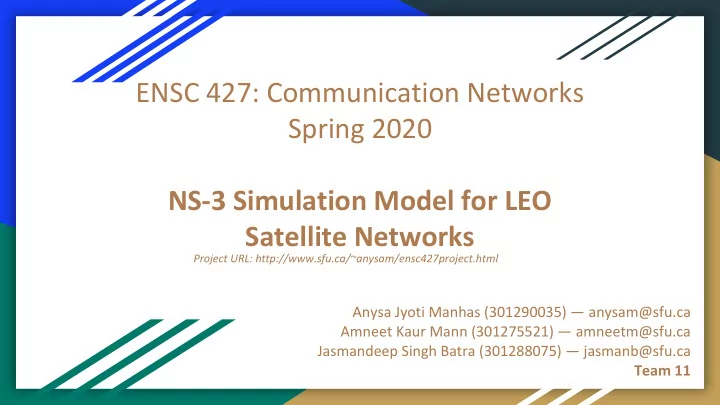

ENSC 427: Communication Networks Spring 2020 NS-3 Simulation Model for LEO Satellite Networks Project URL: http://www.sfu.ca/~anysam/ensc427project.html Anysa Jyoti Manhas (301290035) — anysam@sfu.ca Amneet Kaur Mann (301275521) — amneetm@sfu.ca Jasmandeep Singh Batra (301288075) — jasmanb@sfu.ca Team 11
Roadmap ● Introduction ● Overview of Related Work ● Problem Description ● Implementation ● Discussion & Conclusion ● References ENSC 427: COMMUNICATION NETWORKS, April 6, 2020 | Slide 2 of 31
Roadmap ● Introduction ● Overview of Related Work ● Problem Description ● Implementation ● Discussion & Conclusion ● References ENSC 427: COMMUNICATION NETWORKS, April 6, 2020 | Slide 3 of 31
Introduction ● Low-Earth orbiting (LEO) satellites are an emerging technology for providing global, low-latency broadband Internet services ○ SpaceX is deploying StarLink [1], a constellation of nearly 12,000 satellites [2], to provide near global coverage by 2021 ○ Other examples: OneWeb is deploying a constellation of 588 satellites [2], Amazon’s Project Kuiper will consist of 3236 satellites [3], Telesat LEO [4] ● The Iridium satellite constellation, which provides voice and data connections, became operational in 1998 and consists of 66 satellites at 780 km [5] ● LEO satellites orbit at an altitude between 500 km and 2000 km [6] ○ Lower than geostationary satellites — provide lower latency to transmit data ○ Orbit around the Earth at a speed of about 8 km/s ● LEO satellite networks offer shorter propagation delays than terrestrial communication networks (i.e., fiber optic cables) while offering mobile and broadcast services[7] ENSC 427: COMMUNICATION NETWORKS, April 6, 2020 | Slide 4 of 31
Introduction ● There is currently no implementation for a LEO satellite module in Network Simulator 3 ( ns-3 ) ○ The Iridium LEO satellite constellation is supported in ns2 ● Our project purpose: to construct a LEO satellite constellation network in ns-3 and evaluate network latency ○ LEO satellite nodes to be organized in orbital planes ○ As LEO satellites orbit, the distance of satellites links and the links between satellites will change ○ Packets will be routed between two ground stations through the LEO satellite constellation network ENSC 427: COMMUNICATION NETWORKS, April 6, 2020 | Slide 5 of 31
Roadmap ● Introduction ● Overview of Related Work ● Problem Description ● Implementation ● Discussion & Conclusion ● References ENSC 427: COMMUNICATION NETWORKS, April 6, 2020 | Slide 6 of 31
Overview of Related Work ● Modelling Communications in Low-Earth-Orbit Satellite Networks [8] ○ Explored design and use of LEO satellite networks, and issues related to building satellites networks ○ Pointed to key considerations when evaluating LEO satellite networks: constellation, coverage, frequency issues, multiple access methods, hand-offs, intersatellite network topology ○ Two main types of orbital constellations: polar and inclined ■ The Iridium satellite utilizes a polar orbit with four connections per satellite (two inter-plane and two intra-plane) ○ Lower altitude satellites have a smaller footprint, and require frequent hand-offs between ground stations Figure 1: The interconnection pattern of the Iridium system. Source: [8] ENSC 427: COMMUNICATION NETWORKS, April 6, 2020 | Slide 7 of 31
Overview of Related Work ● Delay is Not an Option: Low Latency Routing in Space [9] ○ Implemented and evaluated a simulation of SpaceX’s StarLink using details provided from SpaceX’s public FCC filing ○ Constellation included 1600 satellites with optical communication links ○ Performed routing by running Dijkstra routing algorithm every 50 ms and caching the results for 200 ms in the future to determine which links will still be present when packet reaches those satellites ○ Evaluated multiple network configurations via modifying links between satellites ○ Concluded that the SpaceX network could provide faster Internet services than terrestrial networks for large distances Figure 2: Networks with varying link configurations simulated Source: [9] ENSC 427: COMMUNICATION NETWORKS, April 6, 2020 | Slide 8 of 31
Roadmap ● Introduction ● Overview of Related Work ● Problem Description ● Implementation ● Discussion & Conclusion ● References ENSC 427: COMMUNICATION NETWORKS, April 6, 2020 | Slide 9 of 31
Problem Description ● To construct a LEO satellite constellation network, we needed to design and implement support for the following structures which were not currently present in ns-3 ○ A mobility model for the LEO satellites in the constellation network ■ Must take into account the total number of LEO satellites in the simulation and configure their positions appropriately ■ Must determine the new positions of the orbiting satellites as time passes according to the speed of the satellites and their orbital plane and direction ■ Must calculate the distance between satellites as they change positions to calculate link delays ○ A mobility model for ground stations interacting with the LEO satellites ■ Must determine position of ground stations ■ Must calculate the distance between themselves and the orbiting satellites ENSC 427: COMMUNICATION NETWORKS, April 6, 2020 | Slide 10 of 31
Problem Description ● To construct a LEO satellite constellation network, we needed to design and implement support for the following structures which were not currently present in ns-3 (con’t) ○ A top level controller module for LEO satellite constellation network ■ Must keep track of all inter-plane satellite links, all intra-plane satellite links, ground station links to satellites, and appropriately trigger link updates between orbiting satellites and between ground stations and satellites ■ Must account for hand-offs between satellites (detaching and reattaching links between satellites so each satellite is only connected to its closest neighbors), and between ground stations and satellites ■ Must keep track of all channels between nodes, their corresponding net devices, and the IP interfaces for each of the nodes ENSC 427: COMMUNICATION NETWORKS, April 6, 2020 | Slide 11 of 31
Roadmap ● Introduction ● Overview of Related Work ● Problem Description ● Implementation ● Discussion & Conclusion ● References ENSC 427: COMMUNICATION NETWORKS, April 6, 2020 | Slide 12 of 31
Implementation Overview of Implementation Figure 3: High level overview of leo-satellite model integrated into ns-3 ENSC 427: COMMUNICATION NETWORKS, April 6, 2020 | Slide 13 of 31
Recommend
More recommend